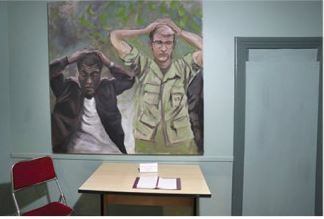Frozen in time, US Embassy a monument to Iran hostage crisis

AP
Tehran, Iran, Nov1 1 : The U.S. Embassy in Tehran remains frozen in 1979 as the 40th anniversary of the Iran hostage crisis approaches, a time capsule of revolutionary graffiti, Underwood typewriters and rotary telephones.
The diplomatic compound was overrun by students angered when Washington allowed ousted Shah Mohammad Reza Pahlavi into the U.S. for medical treatment. What initially began as a sit-in devolved into 444 days of captivity for 52 Americans seized in the embassy.
Today, the embassy remains held by the Basij, a volunteer wing of Iran’s paramilitary Revolutionary Guard, partly as a museum and a space for student groups. Likewise, the Iranian Embassy in Washington remains empty since then-President Jimmy Carter expelled all of Iran’s diplomats during the crisis, although it is closed to the public and maintained by the U.S. State Department.
The 27-acre U.S. compound sits on the corner of Taleghani Street and Mofatteh Avenue, a busy thoroughfare through downtown Tehran.
Before the 1979 Islamic Revolution, Taleghani Street was known as Takhteh-Jamshid Street, the Farsi term for Persepolis, the ancient Persian religious capital. Mofatteh Avenue had been named after U.S. President Franklin D. Roosevelt, whose distant cousin Kermit Roosevelt, a CIA operative, played a role in the 1953 coup that toppled Prime Minister Mohammad Mossadegh and cemented the shah’s power.
The brick gate around the compound has become famous for its anti-American murals. On the day of the takeover, Nov. 4, 1979, Islamic students scaled its fence the same way their Marxist rivals had done earlier that year on Feb. 14.
The earlier incident was broken up by security forces, and an uneasy calm had returned to the embassy, although officials cut its staff to about 70 people.
The Great Seal of the United States on the outside wall has been defaced, although another one still is undamaged in white above the entryway of the compound’s chancery. The two-story office block resembles a U.S. high school, something the diplomatic staff joked about by calling it “Henderson High,” after former U.S. Ambassador Loy Henderson.
Entering the chancery is like stepping back in time. Rooms on the ground floors were shut and locked when Associated Press journalists visited on a recent night. The rooms are used by student groups and others.
Up a staircase, a guide led the AP journalists through the heavy safe door that guarded the embassy’s secure vault room. This area has become part of the Basij museum.
Inside the vault sits the embassy’s communications gear. Those Americans who hid in the room during the takeover rendered the equipment inoperable, removing and destroying individual components of the telexes — teletype machines that could transmit messages over phone lines to the rest of the world.
By destroying only the components, the staff could easily put the machines back into use had Iranian security forces rescued the employees, as they had in the Feb. 14 incident.
“The list was prioritized, so that the last items to go were the secure teletypes that kept them connected to Washington,” journalist Mark Bowden wrote in his 2006 book, “Guests of the Ayatollah,” recounting the crisis. “When it was decided to begin destroying them, selected parts were culled from the various bits and either smashed with a hammer or cut in half with a saw.”
Recent News

Do not make expressions casting dout on election: EC
14 Apr, 2022
CM Bhatta says may New Year 2079 BS inspire positive thinking
14 Apr, 2022
Three new cases, 44 recoveries in 24 hours
14 Apr, 2022
689 climbers of 84 teams so far acquire permits for climbing various peaks this spring season
14 Apr, 2022
How the rising cost of living crisis is impacting Nepal
14 Apr, 2022
US military confirms an interstellar meteor collided with Earth
14 Apr, 2022
Valneva Covid vaccine approved for use in UK
14 Apr, 2022
Chair Prachanda highlights need of unity among Maoist, Communist forces
14 Apr, 2022
Ranbir Kapoor and Alia Bhatt: Bollywood toasts star couple on wedding
14 Apr, 2022
President Bhandari confers decorations (Photo Feature)
14 Apr, 2022











